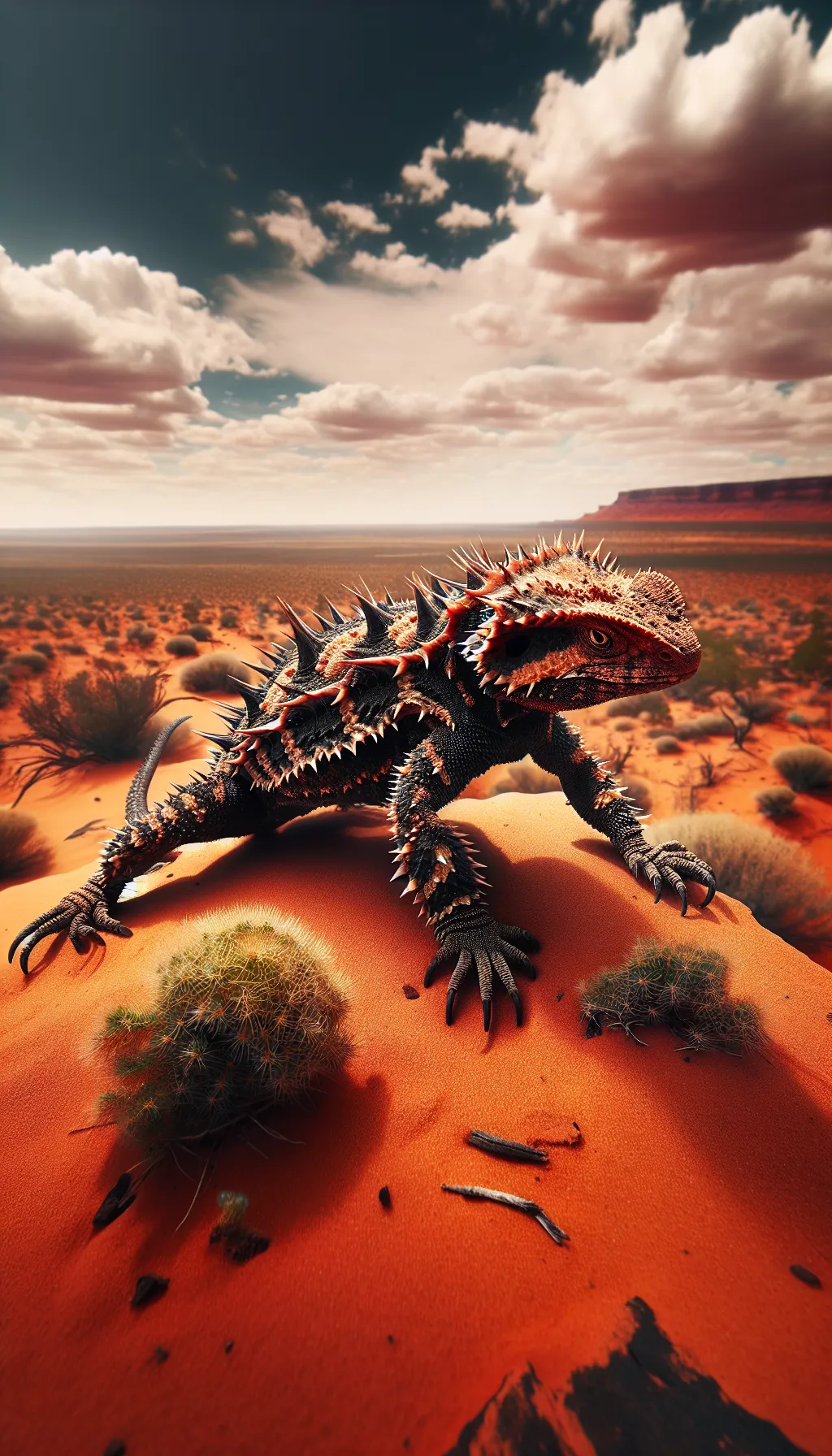The Thorny Devil
The Thorny Devil, also known as the Moloch horridus, is a fascinating species of lizard native to the arid regions of Australia. Known for its incredible camouflage abilities, the Thorny Devil has a unique appearance that helps it blend seamlessly into its environment. This lizard is covered in spiky, thorny scales that serve as both a defense mechanism and a means of thermal regulation. Its body is primarily brown or grayish, with hints of yellow and orange, further enhancing its ability to conceal itself in the desert landscape. The Thorny Devil has a unique adaptation in the form of a false head on the back of its neck, which it uses to deter predators. With a length of around 20 centimeters, this small reptile has long, slender limbs and a tail that easily breaks off if grabbed, enabling it to escape from potential danger.

| Thorny Devil | |
|---|---|
| Size | Relevant measure of height or length in english units: 4.3-4.7 inches (11-12 centimeters) |
| Weight | Weight in english units: 2-4 ounces (60-110 grams) |
| Speed | 0.6mph (1km/h) |
| Key Strength | Quick and agile movements |
| Biggest Weakness | Lack of offensive mechanisms |
| Scientific Name | Moloch horridus |
| Family | Agamidae |
| Habitat | Arid regions of Central Australia |
| Geography | Central Australia |
| Diet | Ants |
| Lifespan | 2 years - 10 years |

The Thorny Devil
The Thorny Devil, also known as the Moloch horridus, is a fascinating species of lizard native to the arid regions of Australia. Known for its incredible camouflage abilities, the Thorny Devil has a unique appearance that helps it blend seamlessly into its environment. This lizard is covered in spiky, thorny scales that serve as both a defense mechanism and a means of thermal regulation. Its body is primarily brown or grayish, with hints of yellow and orange, further enhancing its ability to conceal itself in the desert landscape. The Thorny Devil has a unique adaptation in the form of a false head on the back of its neck, which it uses to deter predators. With a length of around 20 centimeters, this small reptile has long, slender limbs and a tail that easily breaks off if grabbed, enabling it to escape from potential danger.
Fun Fact: Despite its menacing appearance, the Thorny Devil is actually a harmless creature that mainly feeds on ants. Each day, it consumes an impressive amount of ants, which can reach up to one thousand individuals, due to the fact that ants provide the necessary hydration the Thorny Devil needs in its dry habitat.
| Thorny Devil | |
|---|---|
| Size | Relevant measure of height or length in english units: 4.3-4.7 inches (11-12 centimeters) |
| Weight | Weight in english units: 2-4 ounces (60-110 grams) |
| Speed | 0.6mph (1km/h) |
| Key Strength | Quick and agile movements |
| Biggest Weakness | Lack of offensive mechanisms |
| Scientific Name | Moloch horridus |
| Family | Agamidae |
| Habitat | Arid regions of Central Australia |
| Geography | Central Australia |
| Diet | Ants |
| Lifespan | 2 years - 10 years |
Thorny Devil Matchups
We use AI to simulate matchups between the Thorny Devil and other animals. Our simulation considers size, strength, and natural predatory behaviors to determine the most likely outcome.

Can't find the Matchup you want?
Create Your Own MatchupThorny Devil: Diet, Predators, Aggression, and Defensive Behaviors
What do Thorny Devils eat?
Thorny Devils primarily feed on ants, which make up about 70-80% of their diet. They use their long, sticky tongue to catch ants, drinking them up through capillary action. In addition to ants, they also consume termites, small insects, and the occasional plant matter.
Do Thorny Devils have any predators?
Thorny Devils are preyed upon by snakes, birds of prey, and some mammals, such as foxes and dingoes. They rely on their cryptic coloration, sharp spines, and ability to inflate their bodies to deter predators. However, their slow movement makes them vulnerable to being caught by quick predators.
Are Thorny Devils aggressive?
Thorny Devils are generally docile creatures and not known to be aggressive towards humans. They have a calm demeanor and tend to rely on their unique defense mechanisms rather than aggression when feeling threatened.
Do Thorny Devils fight?
Thorny Devils are not known to engage in fights with other animals, as they typically rely on their camouflage and passive defense strategies to avoid confrontation. However, if they feel cornered or threatened, they may display defensive behavior such as inflating their bodies or hissing.
How do Thorny Devils defend themselves?
Thorny Devils have several unique defense mechanisms to protect themselves from predators. Their spiky, thorny skin acts as a deterrent to potential threats, and they can inflate their bodies to appear larger and more intimidating. Additionally, they have the ability to change their color to blend in with their surroundings, making them almost invisible to predators.
What is Thorny Devils' biggest weakness in a fight?
The Thorny Devils' biggest weakness in a fight is their slow movement and lack of agility. While their unique defense mechanisms can deter predators, they are not well-equipped for quick movements or evasive action. This makes them vulnerable to fast-acting predators that can outmaneuver them in a confrontation.
Fun Fact: The Thorny Devil possesses an incredibly efficient system for collecting water. Its skin features a complex network of grooves, allowing it to channel rainwater directly into its mouth. By positioning its body to maximize water collection, the lizard can hydrate itself during rainfalls, sometimes even doubling its body weight.
Fun Fact: This unique lizard is not only renowned for its intricate camouflage and water-collecting capabilities, but also for its ability to change color. The Thorny Devil can adjust its hues based on temperature and external conditions, ranging from darker shades to lighter tones. This color change helps regulate body temperature and aids in concealment from predators and prey alike.











